Marketing Report: Dove and Lynx - International Brand Strategies
VerifiedAdded on 2020/06/03
|10
|2568
|145
Report
AI Summary
This report provides an in-depth analysis of the marketing strategies employed by two international brands, Dove and Lynx, within the consumer retail industry. It examines the importance of marketing for these brands, focusing on their approaches to product standardization and adaptation to different cultural contexts. The report explores the marketing mix variables, including product, pricing, distribution, and promotion, and how they are utilized by each brand. It also delves into market segmentation, targeting, and product positioning strategies, comparing the approaches of Dove and Lynx. The conclusion highlights key environmental and organizational factors influencing the marketing of these products, emphasizing the impact of brand image and innovation on market success. The report emphasizes how Dove has achieved market leadership through attractive packaging, branding, and quality products, while providing recommendations for both brands to enhance their market share through effective promotion mix practices and continued focus on quality.
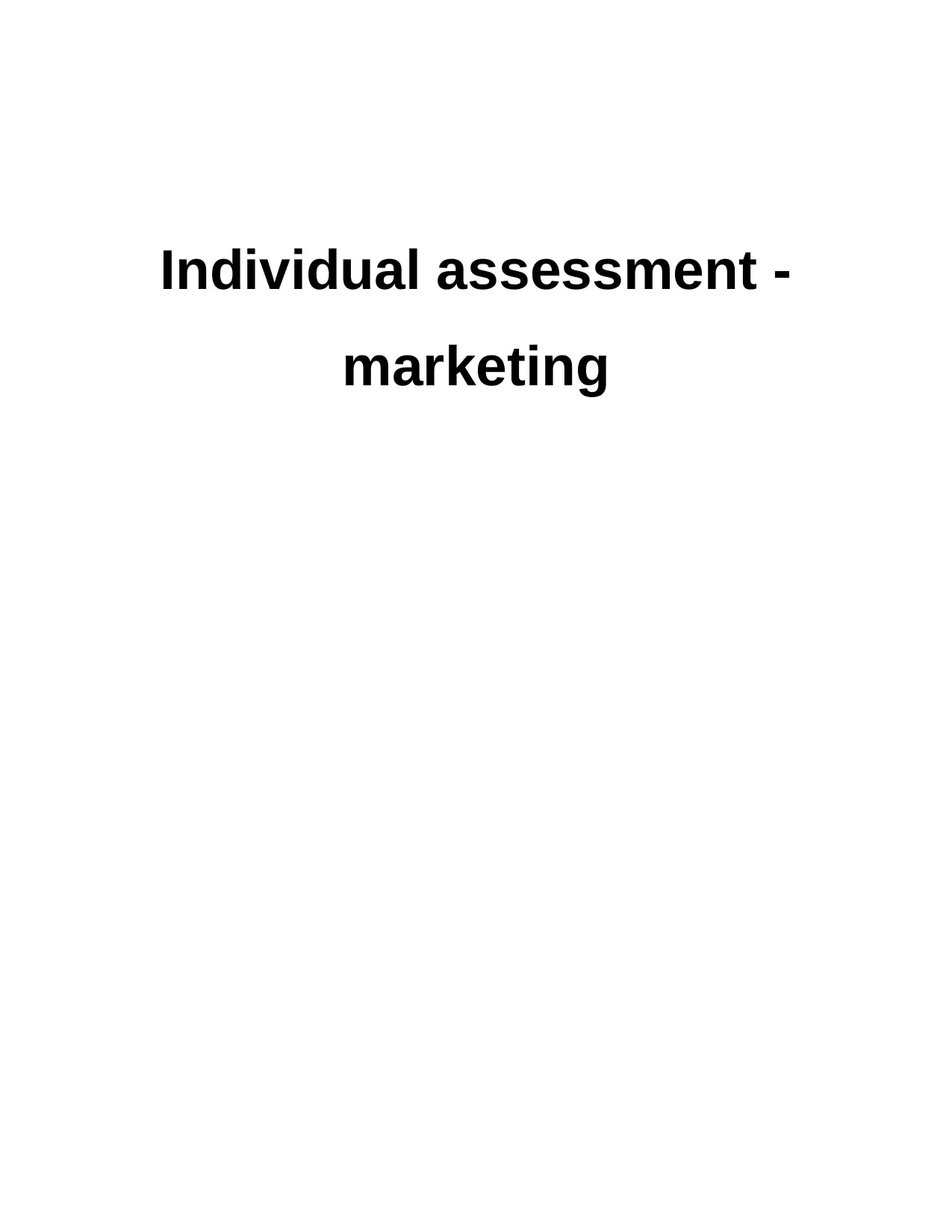
Individual assessment -
marketing
marketing
Paraphrase This Document
Need a fresh take? Get an instant paraphrase of this document with our AI Paraphraser
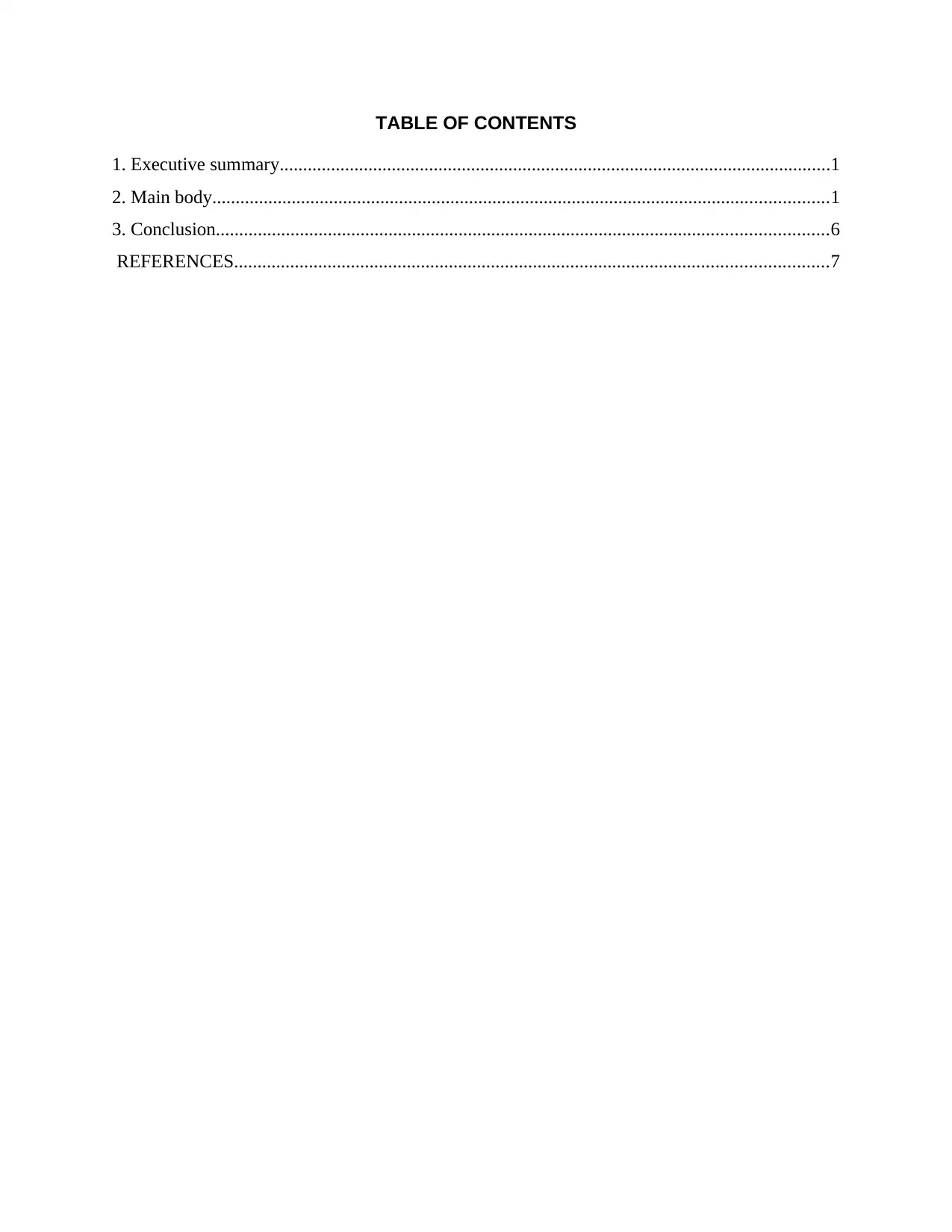
TABLE OF CONTENTS
1. Executive summary......................................................................................................................1
2. Main body....................................................................................................................................1
3. Conclusion...................................................................................................................................6
REFERENCES...............................................................................................................................7
1. Executive summary......................................................................................................................1
2. Main body....................................................................................................................................1
3. Conclusion...................................................................................................................................6
REFERENCES...............................................................................................................................7
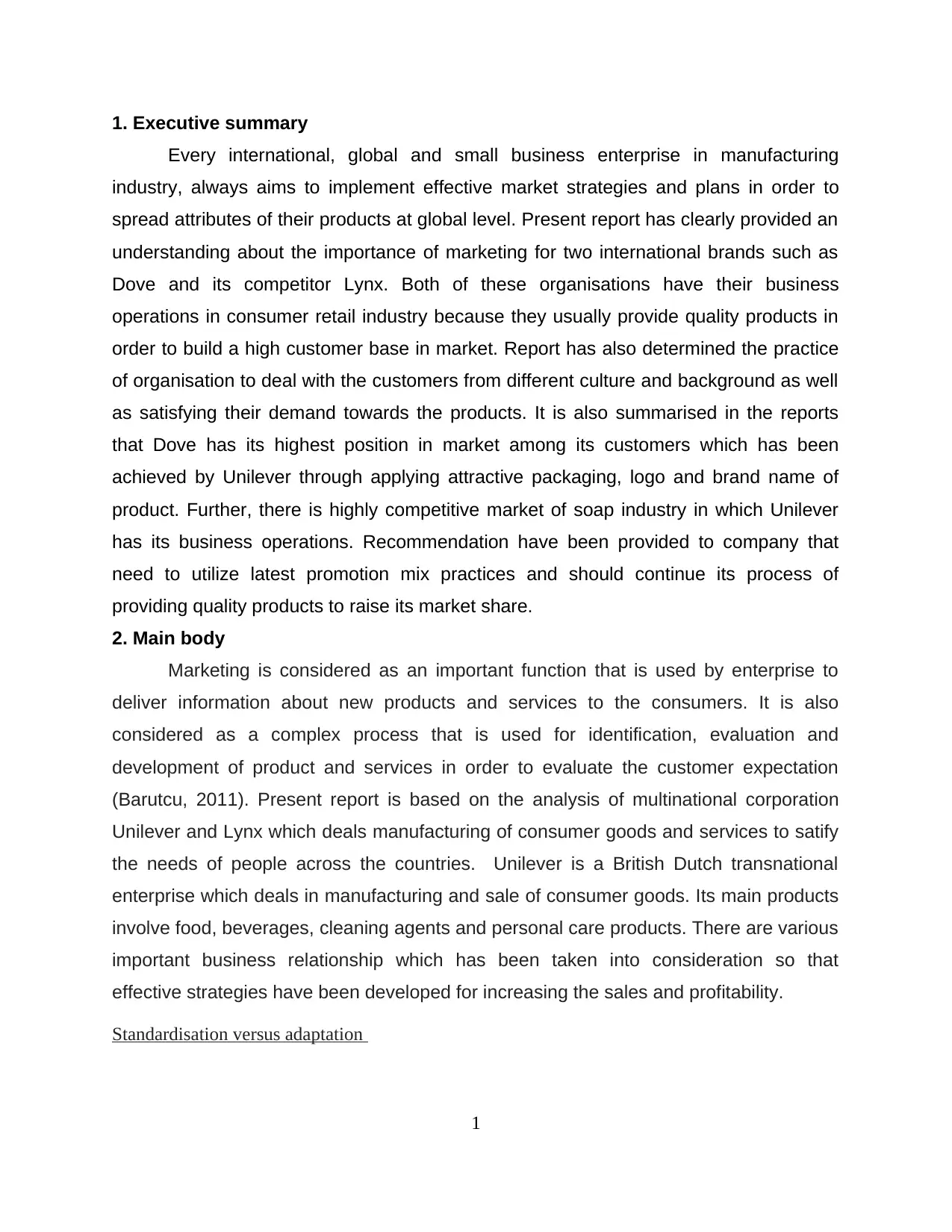
1. Executive summary
Every international, global and small business enterprise in manufacturing
industry, always aims to implement effective market strategies and plans in order to
spread attributes of their products at global level. Present report has clearly provided an
understanding about the importance of marketing for two international brands such as
Dove and its competitor Lynx. Both of these organisations have their business
operations in consumer retail industry because they usually provide quality products in
order to build a high customer base in market. Report has also determined the practice
of organisation to deal with the customers from different culture and background as well
as satisfying their demand towards the products. It is also summarised in the reports
that Dove has its highest position in market among its customers which has been
achieved by Unilever through applying attractive packaging, logo and brand name of
product. Further, there is highly competitive market of soap industry in which Unilever
has its business operations. Recommendation have been provided to company that
need to utilize latest promotion mix practices and should continue its process of
providing quality products to raise its market share.
2. Main body
Marketing is considered as an important function that is used by enterprise to
deliver information about new products and services to the consumers. It is also
considered as a complex process that is used for identification, evaluation and
development of product and services in order to evaluate the customer expectation
(Barutcu, 2011). Present report is based on the analysis of multinational corporation
Unilever and Lynx which deals manufacturing of consumer goods and services to satify
the needs of people across the countries. Unilever is a British Dutch transnational
enterprise which deals in manufacturing and sale of consumer goods. Its main products
involve food, beverages, cleaning agents and personal care products. There are various
important business relationship which has been taken into consideration so that
effective strategies have been developed for increasing the sales and profitability.
Standardisation versus adaptation
1
Every international, global and small business enterprise in manufacturing
industry, always aims to implement effective market strategies and plans in order to
spread attributes of their products at global level. Present report has clearly provided an
understanding about the importance of marketing for two international brands such as
Dove and its competitor Lynx. Both of these organisations have their business
operations in consumer retail industry because they usually provide quality products in
order to build a high customer base in market. Report has also determined the practice
of organisation to deal with the customers from different culture and background as well
as satisfying their demand towards the products. It is also summarised in the reports
that Dove has its highest position in market among its customers which has been
achieved by Unilever through applying attractive packaging, logo and brand name of
product. Further, there is highly competitive market of soap industry in which Unilever
has its business operations. Recommendation have been provided to company that
need to utilize latest promotion mix practices and should continue its process of
providing quality products to raise its market share.
2. Main body
Marketing is considered as an important function that is used by enterprise to
deliver information about new products and services to the consumers. It is also
considered as a complex process that is used for identification, evaluation and
development of product and services in order to evaluate the customer expectation
(Barutcu, 2011). Present report is based on the analysis of multinational corporation
Unilever and Lynx which deals manufacturing of consumer goods and services to satify
the needs of people across the countries. Unilever is a British Dutch transnational
enterprise which deals in manufacturing and sale of consumer goods. Its main products
involve food, beverages, cleaning agents and personal care products. There are various
important business relationship which has been taken into consideration so that
effective strategies have been developed for increasing the sales and profitability.
Standardisation versus adaptation
1
⊘ This is a preview!⊘
Do you want full access?
Subscribe today to unlock all pages.

Trusted by 1+ million students worldwide
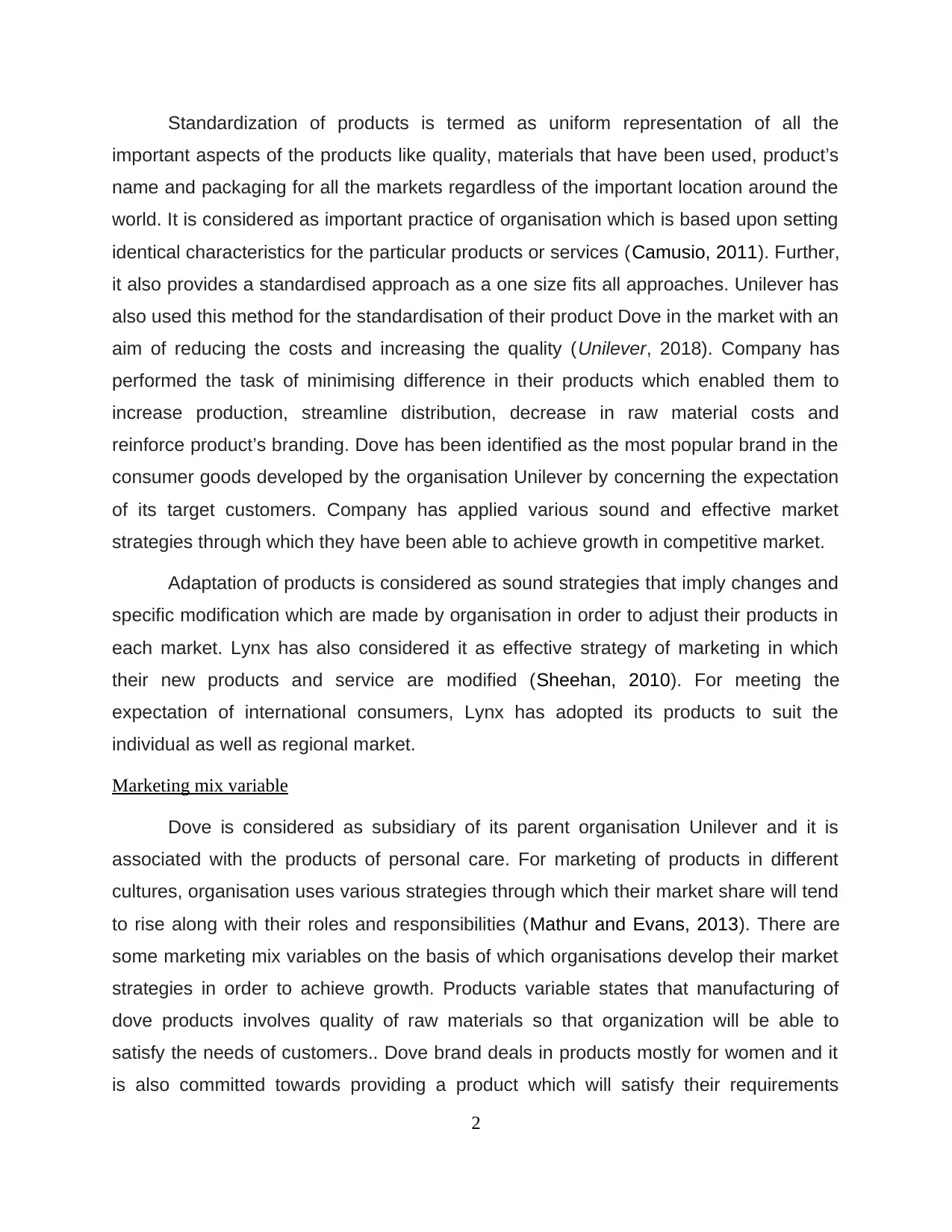
Standardization of products is termed as uniform representation of all the
important aspects of the products like quality, materials that have been used, product’s
name and packaging for all the markets regardless of the important location around the
world. It is considered as important practice of organisation which is based upon setting
identical characteristics for the particular products or services (Camusio, 2011). Further,
it also provides a standardised approach as a one size fits all approaches. Unilever has
also used this method for the standardisation of their product Dove in the market with an
aim of reducing the costs and increasing the quality (Unilever, 2018). Company has
performed the task of minimising difference in their products which enabled them to
increase production, streamline distribution, decrease in raw material costs and
reinforce product’s branding. Dove has been identified as the most popular brand in the
consumer goods developed by the organisation Unilever by concerning the expectation
of its target customers. Company has applied various sound and effective market
strategies through which they have been able to achieve growth in competitive market.
Adaptation of products is considered as sound strategies that imply changes and
specific modification which are made by organisation in order to adjust their products in
each market. Lynx has also considered it as effective strategy of marketing in which
their new products and service are modified (Sheehan, 2010). For meeting the
expectation of international consumers, Lynx has adopted its products to suit the
individual as well as regional market.
Marketing mix variable
Dove is considered as subsidiary of its parent organisation Unilever and it is
associated with the products of personal care. For marketing of products in different
cultures, organisation uses various strategies through which their market share will tend
to rise along with their roles and responsibilities (Mathur and Evans, 2013). There are
some marketing mix variables on the basis of which organisations develop their market
strategies in order to achieve growth. Products variable states that manufacturing of
dove products involves quality of raw materials so that organization will be able to
satisfy the needs of customers.. Dove brand deals in products mostly for women and it
is also committed towards providing a product which will satisfy their requirements
2
important aspects of the products like quality, materials that have been used, product’s
name and packaging for all the markets regardless of the important location around the
world. It is considered as important practice of organisation which is based upon setting
identical characteristics for the particular products or services (Camusio, 2011). Further,
it also provides a standardised approach as a one size fits all approaches. Unilever has
also used this method for the standardisation of their product Dove in the market with an
aim of reducing the costs and increasing the quality (Unilever, 2018). Company has
performed the task of minimising difference in their products which enabled them to
increase production, streamline distribution, decrease in raw material costs and
reinforce product’s branding. Dove has been identified as the most popular brand in the
consumer goods developed by the organisation Unilever by concerning the expectation
of its target customers. Company has applied various sound and effective market
strategies through which they have been able to achieve growth in competitive market.
Adaptation of products is considered as sound strategies that imply changes and
specific modification which are made by organisation in order to adjust their products in
each market. Lynx has also considered it as effective strategy of marketing in which
their new products and service are modified (Sheehan, 2010). For meeting the
expectation of international consumers, Lynx has adopted its products to suit the
individual as well as regional market.
Marketing mix variable
Dove is considered as subsidiary of its parent organisation Unilever and it is
associated with the products of personal care. For marketing of products in different
cultures, organisation uses various strategies through which their market share will tend
to rise along with their roles and responsibilities (Mathur and Evans, 2013). There are
some marketing mix variables on the basis of which organisations develop their market
strategies in order to achieve growth. Products variable states that manufacturing of
dove products involves quality of raw materials so that organization will be able to
satisfy the needs of customers.. Dove brand deals in products mostly for women and it
is also committed towards providing a product which will satisfy their requirements
2
Paraphrase This Document
Need a fresh take? Get an instant paraphrase of this document with our AI Paraphraser

(Roberts and Zahay, 2012). Whereas Lynx brand has understood that preference differs
from person to person, therefore, it has started creation of products with a range.
Products of Lynx come in all the shapes and sizes. Pricing strategies adopted by
Unilever to sell their product is also different from Lynx because Dove has strong brand
image and demand in market as compared to other. It has provided an ability to charge
high prices whereas various substitute brands of Lynx exists in market which has
influenced their sales in market. However, company is providing its product at low prices
to sustain in market and making some changes in their existing products to differentiate
their brand from competitors. Dove is an international brand, having global presence. Its
distribution network is spread in different parts of the world and manufacturing of their
products takes place in various countries like US, UK, China etc. Company involves the
manufacturers to retailers to consumers via general stores, supermarket and
hypermarkets (Moran and Hunt, 2014). Whereas Lynx does not have well-established
channels of distribution like Unilever but they sell their products in more than 200
countries and regions. Major difference is that Lynx brand sales is mostly based on
market of UK whereas Unilever does not have its dependency on European market. For
the promotion of products and service, company has used various important channels
of communication like digital advertisement, social media marketing and newspaper
advertisement. Whereas Brand Lynx is constantly applying the same channels for
promotion of their products in market.
Within its market segmentation, organisation Unilever has claimed that it is the
highest selling beauty soap across the countries and it will not go traditional mass
marketing and it has not segmented their market according to gender (Hartley and
Claycomb, 2013). Study of market has shown that Unilever in Europe has segmented
their market according to the geographical areas. The population of country has been is
divided by company in to three important parts which are urban, sub urban and rural
area consumers. The organisation will further differentiate the geographical segments
among the different cluster as social and economic class people on the basis of
education and income.
Targeting is also considered as important in which organisation want to sell their
products and services and involve a target set of customers for which directs its efforts
3
from person to person, therefore, it has started creation of products with a range.
Products of Lynx come in all the shapes and sizes. Pricing strategies adopted by
Unilever to sell their product is also different from Lynx because Dove has strong brand
image and demand in market as compared to other. It has provided an ability to charge
high prices whereas various substitute brands of Lynx exists in market which has
influenced their sales in market. However, company is providing its product at low prices
to sustain in market and making some changes in their existing products to differentiate
their brand from competitors. Dove is an international brand, having global presence. Its
distribution network is spread in different parts of the world and manufacturing of their
products takes place in various countries like US, UK, China etc. Company involves the
manufacturers to retailers to consumers via general stores, supermarket and
hypermarkets (Moran and Hunt, 2014). Whereas Lynx does not have well-established
channels of distribution like Unilever but they sell their products in more than 200
countries and regions. Major difference is that Lynx brand sales is mostly based on
market of UK whereas Unilever does not have its dependency on European market. For
the promotion of products and service, company has used various important channels
of communication like digital advertisement, social media marketing and newspaper
advertisement. Whereas Brand Lynx is constantly applying the same channels for
promotion of their products in market.
Within its market segmentation, organisation Unilever has claimed that it is the
highest selling beauty soap across the countries and it will not go traditional mass
marketing and it has not segmented their market according to gender (Hartley and
Claycomb, 2013). Study of market has shown that Unilever in Europe has segmented
their market according to the geographical areas. The population of country has been is
divided by company in to three important parts which are urban, sub urban and rural
area consumers. The organisation will further differentiate the geographical segments
among the different cluster as social and economic class people on the basis of
education and income.
Targeting is also considered as important in which organisation want to sell their
products and services and involve a target set of customers for which directs its efforts
3
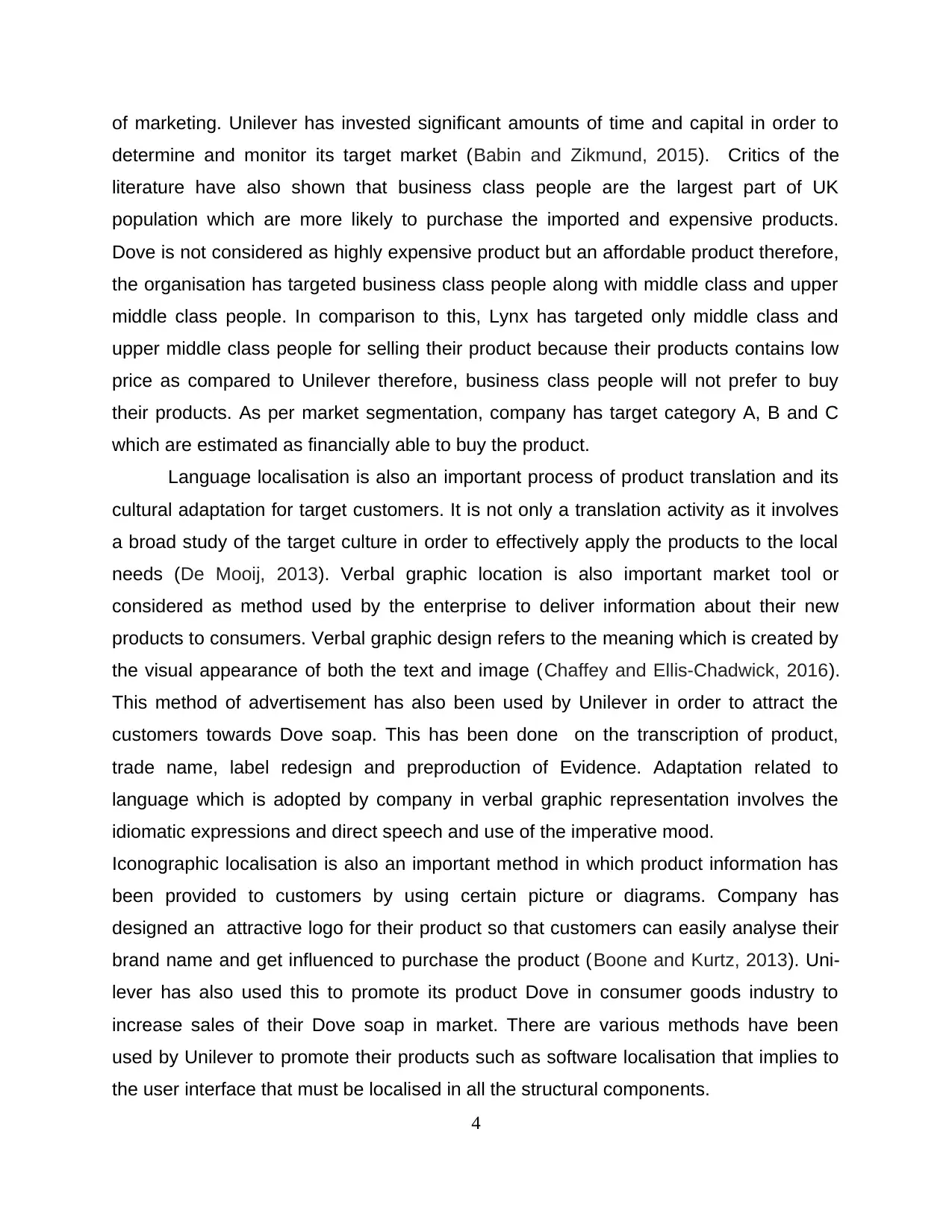
of marketing. Unilever has invested significant amounts of time and capital in order to
determine and monitor its target market (Babin and Zikmund, 2015). Critics of the
literature have also shown that business class people are the largest part of UK
population which are more likely to purchase the imported and expensive products.
Dove is not considered as highly expensive product but an affordable product therefore,
the organisation has targeted business class people along with middle class and upper
middle class people. In comparison to this, Lynx has targeted only middle class and
upper middle class people for selling their product because their products contains low
price as compared to Unilever therefore, business class people will not prefer to buy
their products. As per market segmentation, company has target category A, B and C
which are estimated as financially able to buy the product.
Language localisation is also an important process of product translation and its
cultural adaptation for target customers. It is not only a translation activity as it involves
a broad study of the target culture in order to effectively apply the products to the local
needs (De Mooij, 2013). Verbal graphic location is also important market tool or
considered as method used by the enterprise to deliver information about their new
products to consumers. Verbal graphic design refers to the meaning which is created by
the visual appearance of both the text and image (Chaffey and Ellis-Chadwick, 2016).
This method of advertisement has also been used by Unilever in order to attract the
customers towards Dove soap. This has been done on the transcription of product,
trade name, label redesign and preproduction of Evidence. Adaptation related to
language which is adopted by company in verbal graphic representation involves the
idiomatic expressions and direct speech and use of the imperative mood.
Iconographic localisation is also an important method in which product information has
been provided to customers by using certain picture or diagrams. Company has
designed an attractive logo for their product so that customers can easily analyse their
brand name and get influenced to purchase the product (Boone and Kurtz, 2013). Uni-
lever has also used this to promote its product Dove in consumer goods industry to
increase sales of their Dove soap in market. There are various methods have been
used by Unilever to promote their products such as software localisation that implies to
the user interface that must be localised in all the structural components.
4
determine and monitor its target market (Babin and Zikmund, 2015). Critics of the
literature have also shown that business class people are the largest part of UK
population which are more likely to purchase the imported and expensive products.
Dove is not considered as highly expensive product but an affordable product therefore,
the organisation has targeted business class people along with middle class and upper
middle class people. In comparison to this, Lynx has targeted only middle class and
upper middle class people for selling their product because their products contains low
price as compared to Unilever therefore, business class people will not prefer to buy
their products. As per market segmentation, company has target category A, B and C
which are estimated as financially able to buy the product.
Language localisation is also an important process of product translation and its
cultural adaptation for target customers. It is not only a translation activity as it involves
a broad study of the target culture in order to effectively apply the products to the local
needs (De Mooij, 2013). Verbal graphic location is also important market tool or
considered as method used by the enterprise to deliver information about their new
products to consumers. Verbal graphic design refers to the meaning which is created by
the visual appearance of both the text and image (Chaffey and Ellis-Chadwick, 2016).
This method of advertisement has also been used by Unilever in order to attract the
customers towards Dove soap. This has been done on the transcription of product,
trade name, label redesign and preproduction of Evidence. Adaptation related to
language which is adopted by company in verbal graphic representation involves the
idiomatic expressions and direct speech and use of the imperative mood.
Iconographic localisation is also an important method in which product information has
been provided to customers by using certain picture or diagrams. Company has
designed an attractive logo for their product so that customers can easily analyse their
brand name and get influenced to purchase the product (Boone and Kurtz, 2013). Uni-
lever has also used this to promote its product Dove in consumer goods industry to
increase sales of their Dove soap in market. There are various methods have been
used by Unilever to promote their products such as software localisation that implies to
the user interface that must be localised in all the structural components.
4
⊘ This is a preview!⊘
Do you want full access?
Subscribe today to unlock all pages.

Trusted by 1+ million students worldwide
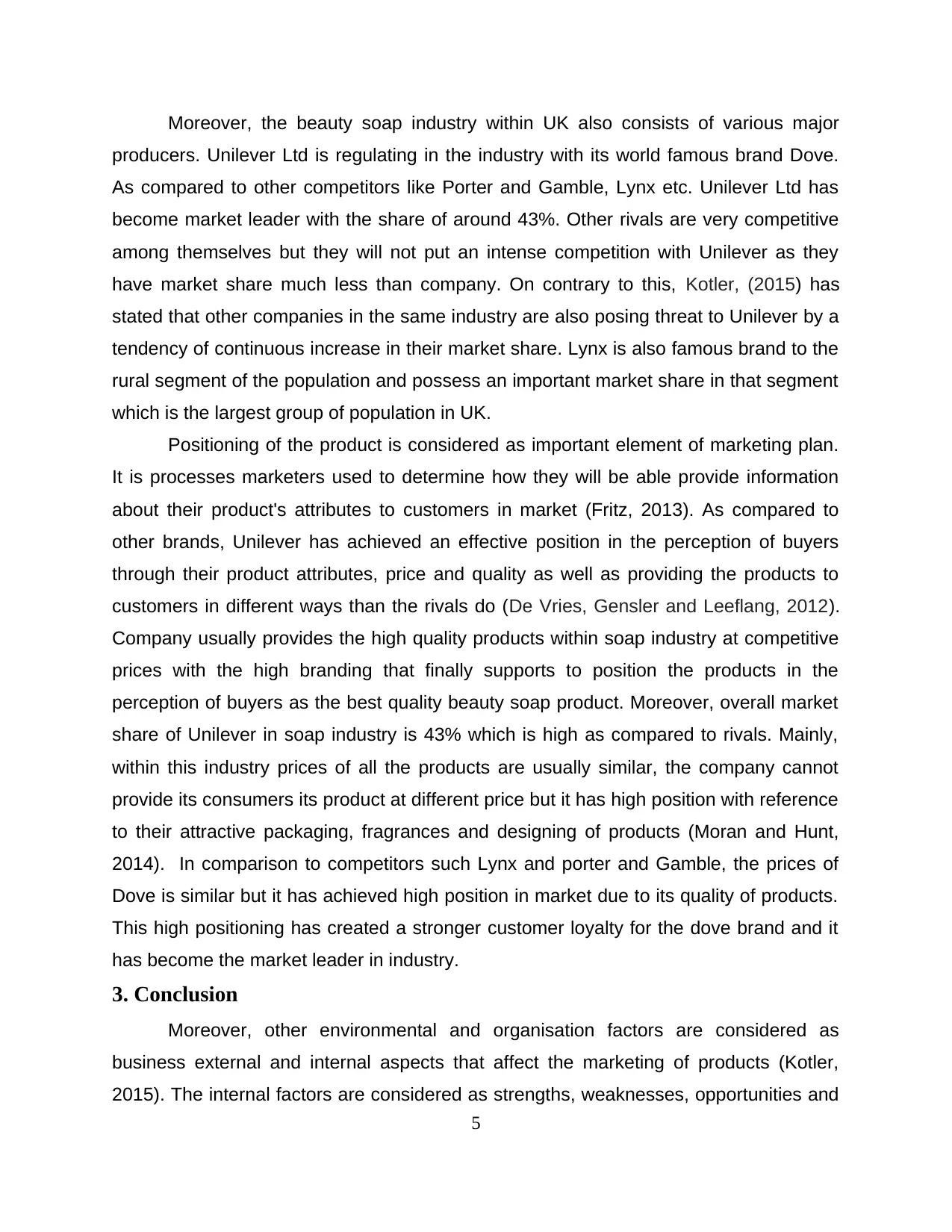
Moreover, the beauty soap industry within UK also consists of various major
producers. Unilever Ltd is regulating in the industry with its world famous brand Dove.
As compared to other competitors like Porter and Gamble, Lynx etc. Unilever Ltd has
become market leader with the share of around 43%. Other rivals are very competitive
among themselves but they will not put an intense competition with Unilever as they
have market share much less than company. On contrary to this, Kotler, (2015) has
stated that other companies in the same industry are also posing threat to Unilever by a
tendency of continuous increase in their market share. Lynx is also famous brand to the
rural segment of the population and possess an important market share in that segment
which is the largest group of population in UK.
Positioning of the product is considered as important element of marketing plan.
It is processes marketers used to determine how they will be able provide information
about their product's attributes to customers in market (Fritz, 2013). As compared to
other brands, Unilever has achieved an effective position in the perception of buyers
through their product attributes, price and quality as well as providing the products to
customers in different ways than the rivals do (De Vries, Gensler and Leeflang, 2012).
Company usually provides the high quality products within soap industry at competitive
prices with the high branding that finally supports to position the products in the
perception of buyers as the best quality beauty soap product. Moreover, overall market
share of Unilever in soap industry is 43% which is high as compared to rivals. Mainly,
within this industry prices of all the products are usually similar, the company cannot
provide its consumers its product at different price but it has high position with reference
to their attractive packaging, fragrances and designing of products (Moran and Hunt,
2014). In comparison to competitors such Lynx and porter and Gamble, the prices of
Dove is similar but it has achieved high position in market due to its quality of products.
This high positioning has created a stronger customer loyalty for the dove brand and it
has become the market leader in industry.
3. Conclusion
Moreover, other environmental and organisation factors are considered as
business external and internal aspects that affect the marketing of products (Kotler,
2015). The internal factors are considered as strengths, weaknesses, opportunities and
5
producers. Unilever Ltd is regulating in the industry with its world famous brand Dove.
As compared to other competitors like Porter and Gamble, Lynx etc. Unilever Ltd has
become market leader with the share of around 43%. Other rivals are very competitive
among themselves but they will not put an intense competition with Unilever as they
have market share much less than company. On contrary to this, Kotler, (2015) has
stated that other companies in the same industry are also posing threat to Unilever by a
tendency of continuous increase in their market share. Lynx is also famous brand to the
rural segment of the population and possess an important market share in that segment
which is the largest group of population in UK.
Positioning of the product is considered as important element of marketing plan.
It is processes marketers used to determine how they will be able provide information
about their product's attributes to customers in market (Fritz, 2013). As compared to
other brands, Unilever has achieved an effective position in the perception of buyers
through their product attributes, price and quality as well as providing the products to
customers in different ways than the rivals do (De Vries, Gensler and Leeflang, 2012).
Company usually provides the high quality products within soap industry at competitive
prices with the high branding that finally supports to position the products in the
perception of buyers as the best quality beauty soap product. Moreover, overall market
share of Unilever in soap industry is 43% which is high as compared to rivals. Mainly,
within this industry prices of all the products are usually similar, the company cannot
provide its consumers its product at different price but it has high position with reference
to their attractive packaging, fragrances and designing of products (Moran and Hunt,
2014). In comparison to competitors such Lynx and porter and Gamble, the prices of
Dove is similar but it has achieved high position in market due to its quality of products.
This high positioning has created a stronger customer loyalty for the dove brand and it
has become the market leader in industry.
3. Conclusion
Moreover, other environmental and organisation factors are considered as
business external and internal aspects that affect the marketing of products (Kotler,
2015). The internal factors are considered as strengths, weaknesses, opportunities and
5
Paraphrase This Document
Need a fresh take? Get an instant paraphrase of this document with our AI Paraphraser
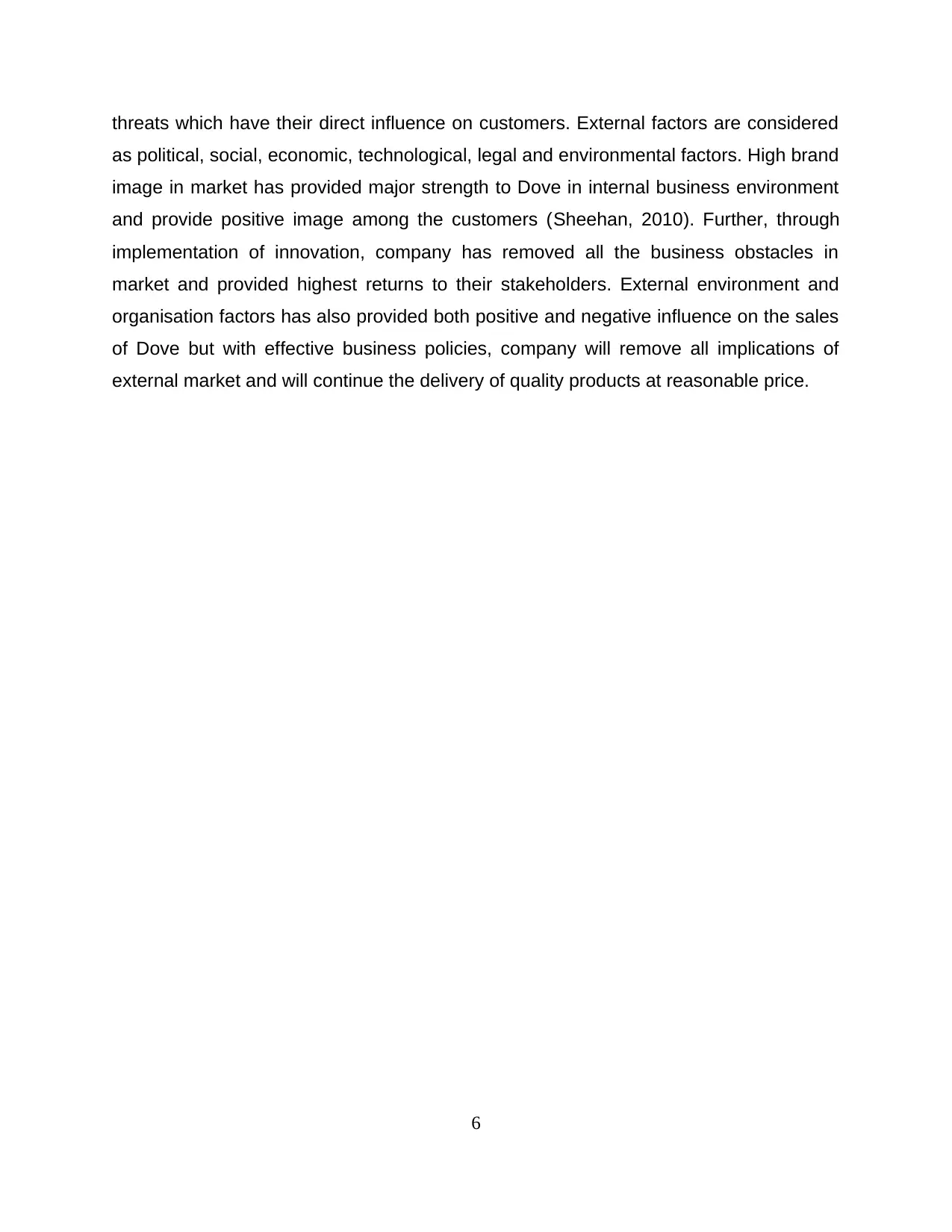
threats which have their direct influence on customers. External factors are considered
as political, social, economic, technological, legal and environmental factors. High brand
image in market has provided major strength to Dove in internal business environment
and provide positive image among the customers (Sheehan, 2010). Further, through
implementation of innovation, company has removed all the business obstacles in
market and provided highest returns to their stakeholders. External environment and
organisation factors has also provided both positive and negative influence on the sales
of Dove but with effective business policies, company will remove all implications of
external market and will continue the delivery of quality products at reasonable price.
6
as political, social, economic, technological, legal and environmental factors. High brand
image in market has provided major strength to Dove in internal business environment
and provide positive image among the customers (Sheehan, 2010). Further, through
implementation of innovation, company has removed all the business obstacles in
market and provided highest returns to their stakeholders. External environment and
organisation factors has also provided both positive and negative influence on the sales
of Dove but with effective business policies, company will remove all implications of
external market and will continue the delivery of quality products at reasonable price.
6
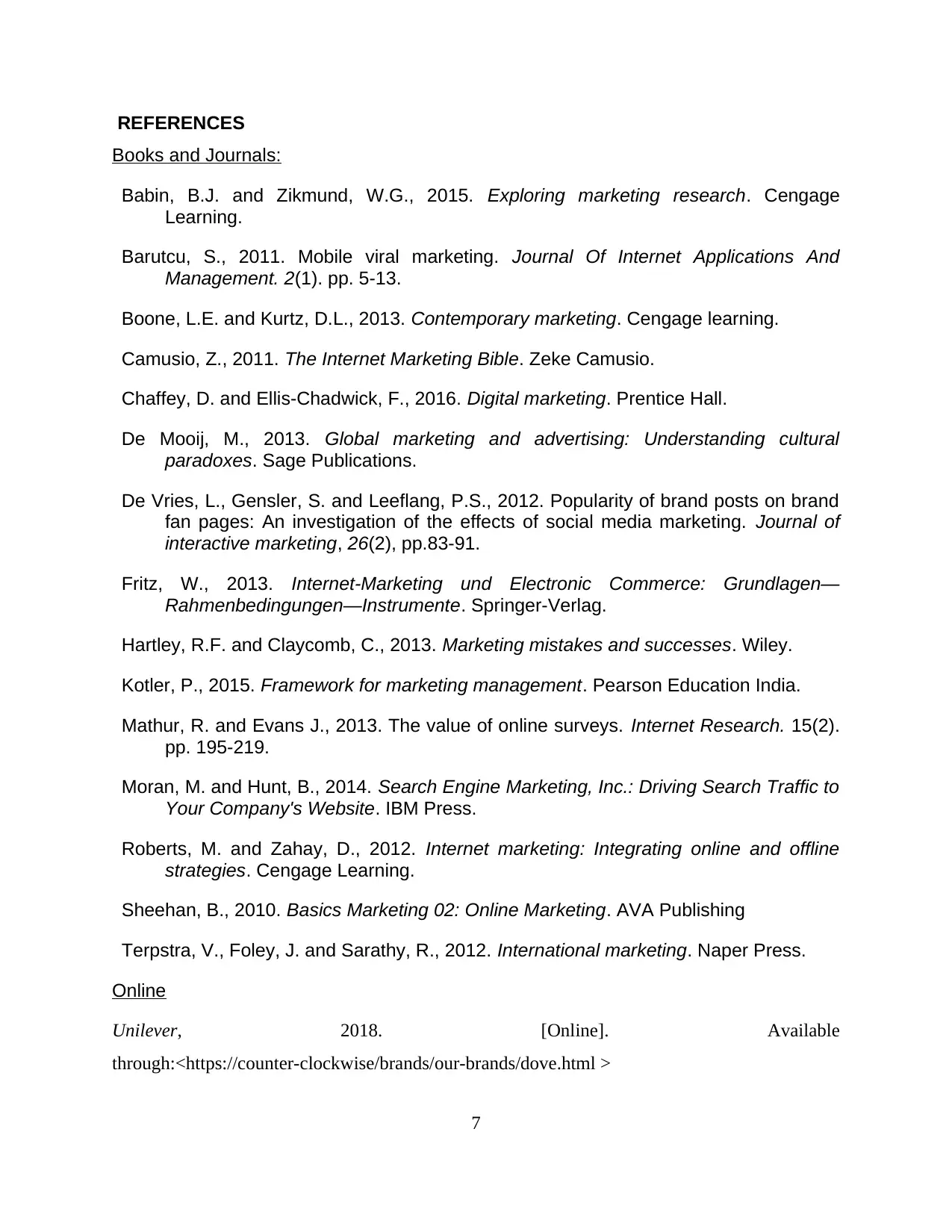
REFERENCES
Books and Journals:
Babin, B.J. and Zikmund, W.G., 2015. Exploring marketing research. Cengage
Learning.
Barutcu, S., 2011. Mobile viral marketing. Journal Of Internet Applications And
Management. 2(1). pp. 5-13.
Boone, L.E. and Kurtz, D.L., 2013. Contemporary marketing. Cengage learning.
Camusio, Z., 2011. The Internet Marketing Bible. Zeke Camusio.
Chaffey, D. and Ellis-Chadwick, F., 2016. Digital marketing. Prentice Hall.
De Mooij, M., 2013. Global marketing and advertising: Understanding cultural
paradoxes. Sage Publications.
De Vries, L., Gensler, S. and Leeflang, P.S., 2012. Popularity of brand posts on brand
fan pages: An investigation of the effects of social media marketing. Journal of
interactive marketing, 26(2), pp.83-91.
Fritz, W., 2013. Internet-Marketing und Electronic Commerce: Grundlagen—
Rahmenbedingungen—Instrumente. Springer-Verlag.
Hartley, R.F. and Claycomb, C., 2013. Marketing mistakes and successes. Wiley.
Kotler, P., 2015. Framework for marketing management. Pearson Education India.
Mathur, R. and Evans J., 2013. The value of online surveys. Internet Research. 15(2).
pp. 195-219.
Moran, M. and Hunt, B., 2014. Search Engine Marketing, Inc.: Driving Search Traffic to
Your Company's Website. IBM Press.
Roberts, M. and Zahay, D., 2012. Internet marketing: Integrating online and offline
strategies. Cengage Learning.
Sheehan, B., 2010. Basics Marketing 02: Online Marketing. AVA Publishing
Terpstra, V., Foley, J. and Sarathy, R., 2012. International marketing. Naper Press.
Online
Unilever, 2018. [Online]. Available
through:<https://counter-clockwise/brands/our-brands/dove.html >
7
Books and Journals:
Babin, B.J. and Zikmund, W.G., 2015. Exploring marketing research. Cengage
Learning.
Barutcu, S., 2011. Mobile viral marketing. Journal Of Internet Applications And
Management. 2(1). pp. 5-13.
Boone, L.E. and Kurtz, D.L., 2013. Contemporary marketing. Cengage learning.
Camusio, Z., 2011. The Internet Marketing Bible. Zeke Camusio.
Chaffey, D. and Ellis-Chadwick, F., 2016. Digital marketing. Prentice Hall.
De Mooij, M., 2013. Global marketing and advertising: Understanding cultural
paradoxes. Sage Publications.
De Vries, L., Gensler, S. and Leeflang, P.S., 2012. Popularity of brand posts on brand
fan pages: An investigation of the effects of social media marketing. Journal of
interactive marketing, 26(2), pp.83-91.
Fritz, W., 2013. Internet-Marketing und Electronic Commerce: Grundlagen—
Rahmenbedingungen—Instrumente. Springer-Verlag.
Hartley, R.F. and Claycomb, C., 2013. Marketing mistakes and successes. Wiley.
Kotler, P., 2015. Framework for marketing management. Pearson Education India.
Mathur, R. and Evans J., 2013. The value of online surveys. Internet Research. 15(2).
pp. 195-219.
Moran, M. and Hunt, B., 2014. Search Engine Marketing, Inc.: Driving Search Traffic to
Your Company's Website. IBM Press.
Roberts, M. and Zahay, D., 2012. Internet marketing: Integrating online and offline
strategies. Cengage Learning.
Sheehan, B., 2010. Basics Marketing 02: Online Marketing. AVA Publishing
Terpstra, V., Foley, J. and Sarathy, R., 2012. International marketing. Naper Press.
Online
Unilever, 2018. [Online]. Available
through:<https://counter-clockwise/brands/our-brands/dove.html >
7
⊘ This is a preview!⊘
Do you want full access?
Subscribe today to unlock all pages.

Trusted by 1+ million students worldwide

8
1 out of 10
Related Documents
Your All-in-One AI-Powered Toolkit for Academic Success.
+13062052269
info@desklib.com
Available 24*7 on WhatsApp / Email
![[object Object]](/_next/static/media/star-bottom.7253800d.svg)
Unlock your academic potential
Copyright © 2020–2025 A2Z Services. All Rights Reserved. Developed and managed by ZUCOL.





